Intel X25-V in RAID-0: Faster than X25-M G2 for $250?
by Anand Lal Shimpi on March 29, 2010 8:59 PM ESTMissing TRIM - Does it Matter?
Clearly the performance of two X25-Vs in RAID 0 is great, but you do lose TRIM - isn't that a dealbreaker? Honestly, it depends. For sequential accesses, TRIM isn't necessary on the Intel drives. The X25 controller does a good job of aggressively cleaning and recycling NAND blocks and you'll pretty consistently write at peak performance if your workload is almost all sequential.
The more random your access pattern is, the more you'll miss TRIM. Thankfully desktops don't spend too much of their time randomly writing data across the drive, but I'd say a good 30% of most desktop writes are random to an extent. Over time, these random writes will build up and bring down the overall performance of your RAID array until you either secure erase the drives or write sequentially to all available free space.
There is one other option for curbing the performance degradation before it happens. Remember the relationship between spare area and write amplification:
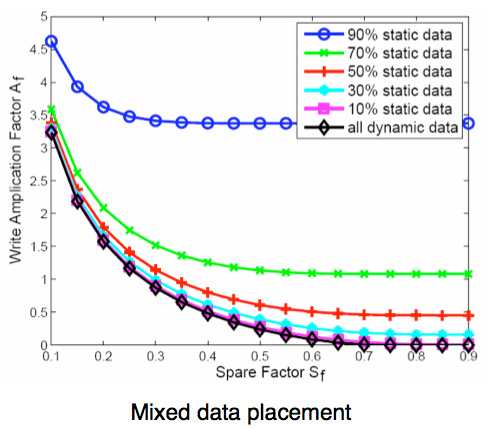
The more random your workload, the higher your write amplification (and thus the lower your performance, shorter your NAND lifespan). Increasing spare area can go a long way to reducing write amplification. While it can't eliminate it, it can definitely make a dent.
If you're looking to keep performance as high as possible with a pair of X25-Vs in RAID, you can always allocate more NAND as spare area. Secure erase each drive, create your RAID array, and then create your partition on the drive smaller than max capacity (try 10 - 20% smaller). The unpartitioned space should automatically be used by the controller as spare area. To test the effectiveness of this approach I took an X25-V, filled it with garbage data, and then wrote random data across the drive as fast as possible for 20 minutes. I then ran HD Tach to get a visualization of write latency (expressed by sudden drops in bandwidth) vs. LBA:
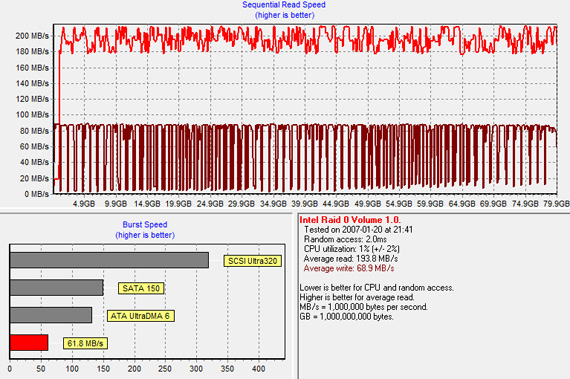
A standard 80GB X25-M wouldn't be this bad off, the X25-V gets extra penalized by having such a limited capacity to begin with. You can see that the drive is attempting to write at full speed but gets brought down to nearly 0MB/s as it has to constantly clean dirty blocks. Constant TRIMing would never let the drive get into this state. It's worth mentioning that a desktop usage pattern shouldn't get this happen either. Another set of sequential writes will clean up most of this though:
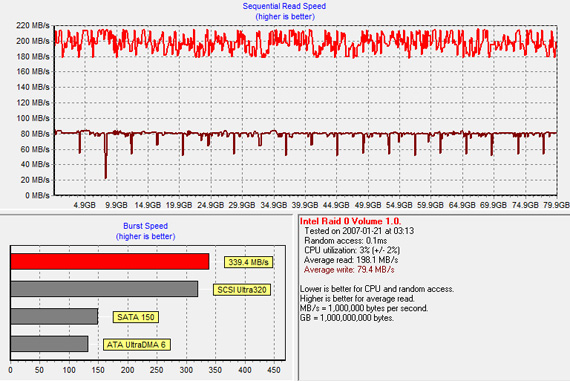
Intel's controller is very resillient. Even without TRIM, as long as your access pattern has some amount of a sequential component you'll be able to eventually recover performance.
Now look at what happens if we only use 60GB of the 74.5GB RAID 0 array upon creation and run the same test:
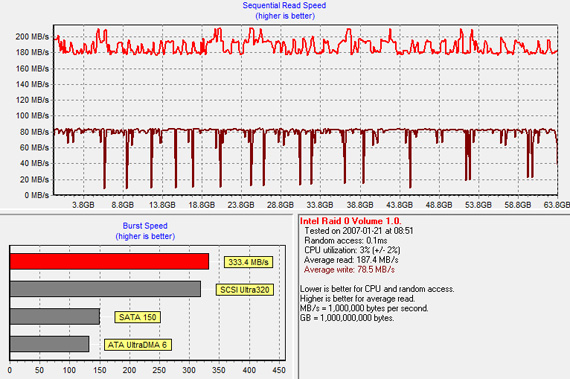
Performance isn't nearly as bad. That added spare area really comes in handy. Of course another pass corrects nearly everything:
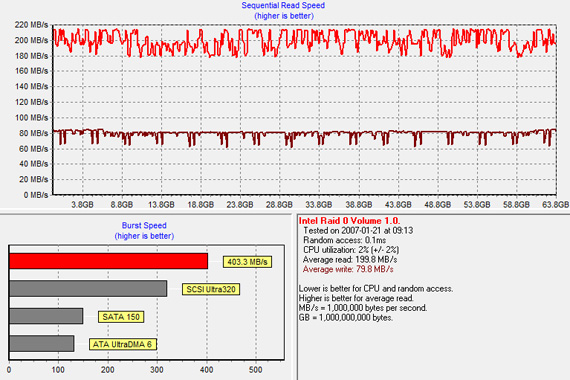
If you don't need the added space, using a smaller partition is a great way to ensure high performance for as long as possible. The effectiveness of this approach is a difficult thing to benchmark given that it's only after months of normal use that you get enough random writes to the drive to be a problem. The good news is that even if you bombard the X25-Vs with random writes, the drives can quickly recover as soon as they're hit with some sequential data.










87 Comments
View All Comments
7Enigma - Tuesday, March 30, 2010 - link
So then why doesn't the major players offer this type of tool that works in the background? You'd have a little background task that once a week @ 2am does this when it detects no disk activity and TRIM wouldn't be important except in very rare circumstances where the drive gets no downtime (say server). Just like an unobtrusive virus scan or more apt a SSD defrag!?I have an G2 Intel 80gig and even though I have the latest firmware that supposedly TRIM's on it's own I once a month use the little toolbox utility to manually TRIM. It would be very nice if they offered a program like this to the G1 owners that they basically slapped in the face....
This is along the same lines as GPUTool. For my 4870 which runs hot at idle for no reason I can drop down 40-80 watts just by downclocking and yet it takes a 3rd party to offer this?
Bolas - Tuesday, March 30, 2010 - link
I thought TRIM was enabled for RAID now, due to a new firmware patch to the Intel chipset?!? Wouldn't that entirely change the outcome of this article?WC Annihilus - Tuesday, March 30, 2010 - link
No. As per Makaveli's reply to GDM, the new Intel drivers do NOT enable TRIM for RAID. They only allow pass through to SSDs not in an array, ie single SSD + RAID hard drives, TRIM now makes it to the SSDRoomraider - Wednesday, March 31, 2010 - link
New Intel chipset drivers do in fact enable trim only with raid-o array in windows 7. Read the documentation properly. It says any trim enabled SSD in Raid -0 only with Windows 7.jed22281 - Friday, April 2, 2010 - link
"New Intel chipset drivers do in fact enable trim only with raid-o array in windows 7. Read the documentation properly. It says any trim enabled SSD in Raid -0 only with Windows 7. "Where's this doco?
Thank-you very much.
Roomraider - Wednesday, March 31, 2010 - link
You my friend are absolutely correct. My read trippled my write more than doubled with 2xM 160 g2'. With trim verified enabled & working.AnalyticalGuy2 - Tuesday, March 30, 2010 - link
Great points and questions GullLars!! Don't give up!!
What about the possible merits of keeping the drives independent? At the very least, you get to keep Trim. And maybe there is an advantage to having 2 independent data paths leading to the drives? Or to having 2 independent controllers?
My goal is to minimize the time it takes to: boot Windows 7, allow the anti-virus to scan startup files and download updates, and load several applications into RAM.
Question: Would this be faster with:
A) One Intel 160GB G2 SSD (by the way, a 10-channel controller, right?)
B) Two independent (i.e., no RAID involved) Intel 80GB G2 SSDs -- One for Win 7 and the other for anti-virus and applications? (by the way, each SSD has a 10-channel controller, for a total of 20 channels?)
GullLars - Tuesday, March 30, 2010 - link
B would be faster, since each of the drives can then work independently in parallell. If you do something that hits both drives to read sequentially at the same time, you get 400+ MB/s read.A guy on a forum i frequent tried using W7 software RAID in hope of getting TRIM on Intel SSDs, it didn't work. Performance was comparable to ICH10R RAID.
I would still reccomend using the two x25-M 80GB in RAID over your option B, since then you always get the doubling of sequential performance. Write degradation whitout TRIM is not a problem in most realistic cases when you're RAIDing, and you likely won't notice anything. If you should notice anything, writing a large file to all free space untill you have written 2-3x of the capasity will likely restore the performance to simelar levels as fresh. You can also increase the spare area a bit and greatly reduce the impact of random writes on performance. I would consider partitioning 2x x25-M 80GB to 140GiB if you anticipate a lot of random writes and few sequential, or just is afraid of performance degradation.
Beanwar - Tuesday, March 30, 2010 - link
Anand, have you considered using Windows software RAID on two of these drives? If you're not using the hardware RAID, you should be able to pass TRIM commands to the drives, and given that even the newest applications out there aren't going to be sending all CPU cores to 100%, it's not like the overhead is going to be all that bad. Just a thought.xyxer - Tuesday, March 30, 2010 - link
Don't intel rapid storage 9.6.0.1014 support TRIM ? http://www.hardwarecanucks.com/news/cpu/intel-chip...